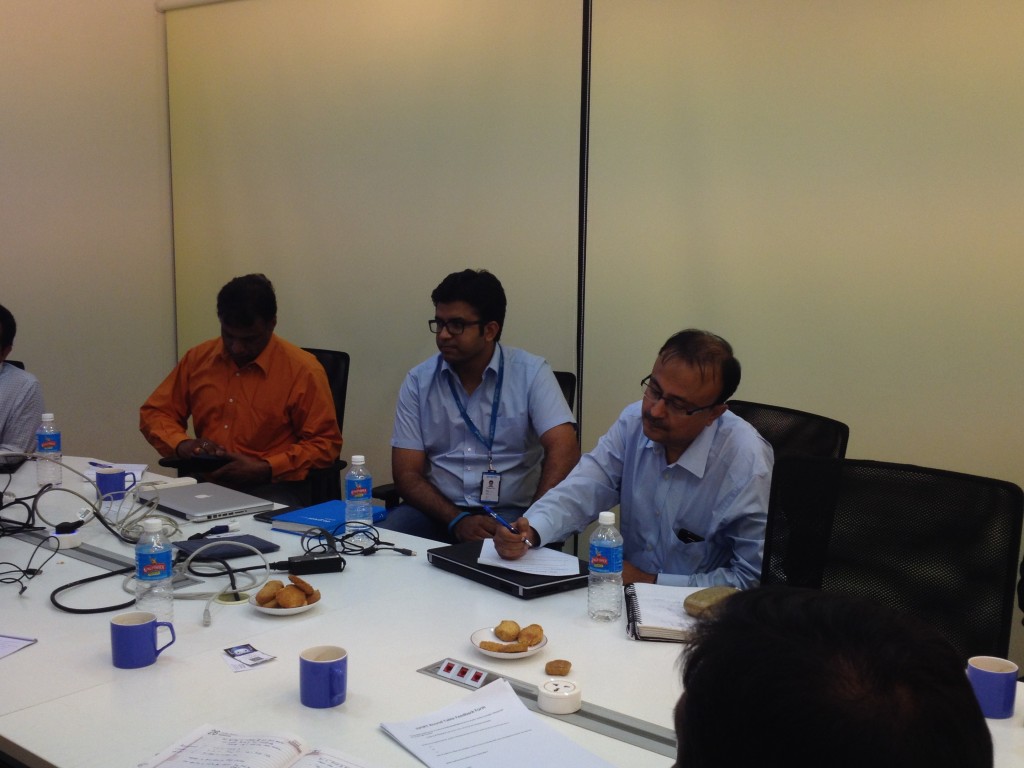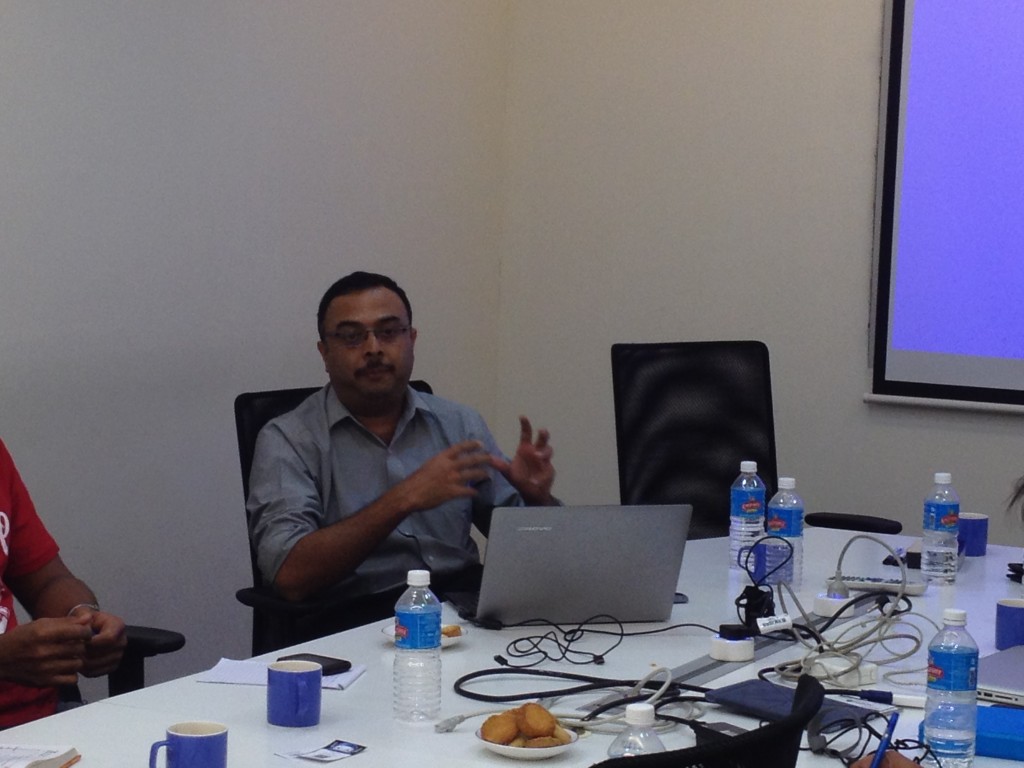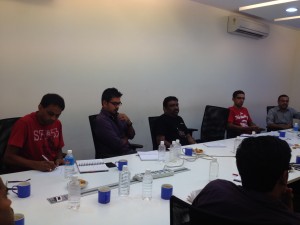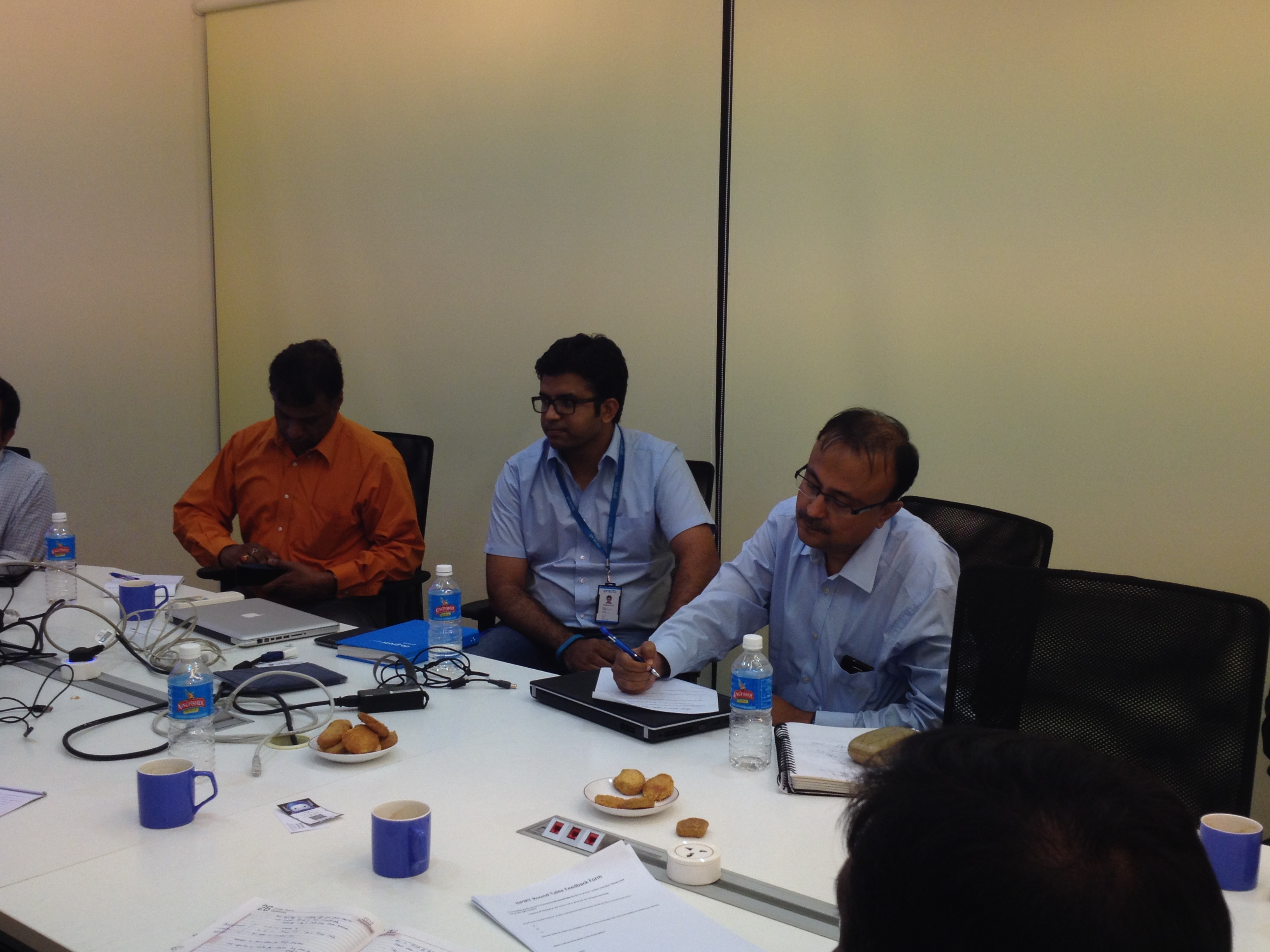Yet another extremely educational round table from iSPIRT – 8 out of 12 participants gave it a rating of 10/10! Girish from GreyTip and Shashank from Practo led the round table and Aneesh and Yashwanth contributed with their experience at Capillary. This article captures some of the key learning from the round table.
The focus of this round table was on acquiring the initial set of customers, particularly in the context of SME segment in India. However, several takeaways are applicable in a general context too. Other topics included early product management, hiring and motivating the sales team and channel partners, and product pricing.
Acquiring your first customers
One of the most common and biggest pain points for a startup is getting the initial customers. Enterprises don’t want to talk to start-ups as they are looking for a mature, tried and tested product. Channel partners also do not want to talk to start-ups unless they have proven sales record and reference customers. It’s a catch 22 situation. Add to that the long sales cycle of 2 to 6 months and it can be a very frustrating experience.
Shashank shared the learning from Practo’s journey of acquiring the initial customers:

- For the first 50 customers, the CEO did the sales and got them to sign up.
- The focus on the first 50 customers was on product market fit (more from product management perspective than customer acquisition).
- Early on, they were not focused on pricing, but on getting people to use it.
- They went behind early adopters who were open to technology and did not try to engage with the late majority or the laggards. For example, if they found a doctor using an old feature phone, they would not consider him as an early adopter. Lead qualification is very important. Focus on quality leads rather than trivial leads.
- In the earlier days, they segmented the market and targeted only dentists in Bangalore and only later expanded to other geographies and kinds of doctors.
- They spent almost the first year and half to figure out what the customer wanted.
- Some of the unique things they did included not giving any incentive to existing customers to refer other customers. They wanted the customer to find so much value in their offering that they would refer on their own. They had a zero referral fee policy as they wanted genuine references.
According to Shashank, four key things that they did right were:
- Spending hours with the USERS to understand their needs. They measured each and every action the user is doing and used it to qualify the lead. They had in-built tools in their product to measure usage.
- They build for needs that can SCALE to several other users.
- Focusing on PAID needs.
- USAGE was their best friend.
Girish from Greytip talked about his journey from being on-premise only software to providing a cloud based solution too. They launched their SAAS version in 2007 when it was still nascent. To experiment, they built a small product on SAAS. They used the beachhead strategy i.e. get a first achievement that leads way to future successes. The beachhead strategy goes by the name of MVP (minimum viable product) these days.

During the beachhead stage, they validated aspects such as customer need, data center hosting, cloud strategy, multi-tenancy etc. Once they saw traction, they realized there is a much bigger market and they started adding more features to the product and scaling sales. And they experimented with different things such as free trials, doing the sale completely online etc. They also tried SEO and SCM.
For their product, they saw that free trial did not work. Nor did they see a sale being done completely online. Girish’s hypothesis is that for their kind of product (payroll), people want someone to speak to and hold responsible for delivery and timeliness. On the other hand, some companies have got all their sales in the Indian B2B context fully online. That is why it is crucial to validate the assumptions in the problem space and target market.
The key takeaway is to experiment different things to figure out what will work for a given product in a given market context. SEO, SCM, Adwords got them leads, but fulfillment was never 100% online. It required a human to close the deal.
Do a bunch of experiments and have clear metrics on what you want to measure to decide the effectiveness of the experiment.
Getting the first customer takes the longest time. Getting the second customer takes much lesser time. Getting the 10th customer is much faster and getting the 100th customer more so. Customer acquisition time drops exponentially.
Metrics is always useful to convince value to customer. Have an ROI calculator. Quantify the perceived loss of not using your product.
To get initial customers, do whatever it takes. Keep chasing the right guys. Use personal references and networking to get meetings. Once you get the meeting, then it is up to the product fit and normal sales cycle.
One company got their first customer after 10 months. And then it took them 14 more months to get to 10 customers.
Get 5 or 6 testimonials and users who love your product and only then go aggressive on sales. Build the product along with 5-6 target customers. First, figure out if there is a need for the product. Follow the lean startup model that is quite popular in startup literature. It really works!
In these times, the product has to give Instant Gratification when the customer tries the product for the first time. For example, with Practo, a doctor can send SMS to a patient within 30 seconds of starting trial. Also, using the product for the first time should be very easy.
Getting references from existing customers is the best method for a startup to acquire more customers. Along with references, cold calling is also needed to get more leads.
For startups founded by young entrepreneurs, age can be a concern in some domains, as some people give more credibility to age. For these kinds of startups, spending efforts to acquire additional credibility helps. For example, you can enlist the services of an industry veteran. Or use an existing customer base as a reference. Customers listen to someone from their community. For example, Scheme Central went through the secretary of the jewelry association and was able to get a huge community of jewelers sign up for their promotional event.

Create case studies. And put in metrics and data points in the case study that communicates the value very clearly.
A new product needs investment in marketing for awareness creation. Webinars help in thought leadership and credibility. You should share best practices and industry trends in webinars. In the last 10% time you can talk about your product. However, the results may not be immediate. Use technologies like webex, gotomeeting, gotowebinar.
Tradeshow presence helps in getting rid of the startup tag and establishes credibility. Use tradeshows also to educate about new things, establish thought leadership and engaging the community. Tradeshows are also places where you can get time from people, who are otherwise too busy in their work to take time out for you. Try to connect with and setup meetings with interested parties before the event, so you can get more mileage out of the event.
Hiring and Motivating Salespeople
Startups need passionate team members for sales. In the early stages, professional sales people are not needed, but passion is more important.
Sales culture and values are very important. Different companies have different values, but it is important to articulate your culture and values so the new employees can identify and relate to the culture. For example, one aspect of the values could be that “We will not give any discounts”. This can help in reducing the sales cycle since there is no negotiation phase.
Build internal tools for sales tracking, conversions and product usage. It might be worthwhile to have a dedicated engineer to build and maintain sales tools.
It is not very difficult to hire foot soldier sales in India for SME sales. Some companies have hired sales people with 2 years’ experience for 25K INR per month. Naukri is a good place to hire junior sales people.
For a startup, it might be better to hire a little experienced folks instead of freshers. In addition to training costs, freshers also have the urge to look out for a change after an year or two. Attrition is higher among lesser experienced employees.
The key things to look while hiring a sales person are:
- Communication skills
- Sales ability. In the interview, ask him to sell his current product to you.
- Relevance. Right background.
- Attitude.
As you scale, investing in the right recruiter is very important as it is very important to hire good candidates.
Act quickly on mistakes. If you find someone who is not right, let go immediately. Typically, 1 out of 2 sales is good fit.
Have a transparent incentive system. And make it non-linear so the salesperson is incentivized to achieve more. For example, if the salesperson gets 1 to 3 deals, the incentive is Rs X per deal. For the 4th through 7th deals, the incentive is 2X and for the 10+ deals, it is 3X.
While it is important to track results, for salespeople tracking effort is also important. It helps in improving morale. For example, effort metrics are things such as number of meetings per week, 4 demos a day etc.
Early Product Management
The product requirements should be driven by the needs of the customer. Aneesh also mentioned that they built the product after talking to retailers (their target customer segment). The first five customers gave them the requirements and then they build the product.
Till you get 100 or so customers (the number might be different for your product), keep making modifications so you have a good minimum viable product (MVP).
Free trials are a great way to get customers. The trial period can be 15 days, 1 month or 3 months or whatever is appropriate in your context. This depends on how soon the customer can see the value of the product. If the value is immediate, then a 15 day trial should be good enough.
If a customer asks for feature X that is not currently available, ask them to pay for it, or tell them to buy the existing product and give them a commitment on when the new feature will be ready. In India, people don’t want to say no directly and hence may come up with different missing features to indirectly say no. Ask other customers if they want the same feature X. If 20% customers need it, then build it.
Build metrics in your product so you can measure which features are being used by customers. This can also help in manage the funnel. For example, you can take these actions based on usage during the trial period.
- Who is using it? Convert these people to paying customers.
- Who is not using it? Extend trial.
- Who is not using at all? Train them.
SME mindset
Pay particular attention to the most common mindset in your target segment. For example, some SMEs have budget constraints. So being flexible in your pricing might be needed. In large enterprises, things run on budgets, so we need to be sensitive to that too. In India, price negotiation and discounts are normal expectations. You will have to decide how you want to handle this.
If the product delivers value, people will pay for it. It is not true that the SME segment in India does not want to spend money.
In the Indian B2B SME context, the customer wants to buy from a person. In the B2B SME context, another important factor is local language communication. Not everyone is English savvy or comfortable doing business in English. So they hired local language speaking sales people.
“Me too” syndrome is prevalent in SME segment in India. They are well connected with each other. You can leverage the “me too” syndrome by using names of your customers competition who is using your product.
SME sales can take a few weeks to a few months, depending on the kind of product and the kind of market. If there are multiple decision makers, sales complexity increases and it can take a minimum of 3 months.
In India, customers don’t say no directly. They might give a variety of reasons to not make the commitment and you might mistake that for genuine interest in the product. Get them to say “Yes” or “No”. Any concrete answer is a good answer.
Channel Partners
Get at least 10 customers yourself so you have established product-market fit. And then go talk to channel partners. Channels will not solve the sales problem for you. You solve it first and that will get the channel excited. They can help you replicate, but not create the sales model.
Channels want to make money. They don’t want to invest in your product. They want to take up already proven products. You might want to put your sales guy in the channel partner’s office and make sure channel partner is making money. Channels will take time and effort.
SAAS products are not exciting for channels as the ticket size is small and they don’t have much scope for making money from implementation and upgrade services. In SAAS, you need to give higher commissions. You can use channels to increase awareness. For SAAS, marketing is more important than channel partners.
For straight forward low touch products, you deal with distributors and resellers (e.g. anti-virus software). Channel partners are typically used for high touch, high involvement kind of solutions where the partner brings in some perceived value addition.
Thoughts on Pricing
Here are some rules of thumb to arrive at product pricing:
- What is the customer currently paying to solve the problem? For example, is it a person whose salary is the cost? Or it is on-premise software that you are replacing with a SAAS solution? Your product pricing has to be less than what the customer is currently paying.
- Your cost of customer acquisition should be less than the annual revenue from the customer. Otherwise, it might not be a sustainable business. Cost of customer acquisition is roughly equal to total salary of sales people + some % markup for additional costs associated with an employee divided by the total number of customers acquired. The formula might vary based on your cost model (e.g. advertisements), but you need to figure out a simple handy customer acquisition cost calculator even if it is not accurate.
- Life time value of the customer should be at least 3 time annual revenue from the customer (=1/churn).
Some Tips and Reference Material mentioned in the round table
- 6 Cs of SAAS metrics and other resources, available at www.bvp.com.
- A book titled “Solution Selling”.
- Some of the participants found yesware.com a very good tool for salespeople. It tells interesting things about whether a prospect opened a mail, forwarded it etc.
- Slides used by Shashank at the round table are here.
- A very good blog for startup sales is http://www.bothsidesofthetable.com/2013/06/13/why-your-startup-needs-a-sales-methodology/ (PUCCKA model).
Tweetable Tweets
Getting the first customer takes the longest time. Customer acquisition time drops exponentially. Tweet this.
To get initial customers, do whatever it takes. Keep chasing the right guys. Tweet this.
Experiment with different models in your specific context to figure out what will work. Tweet this.
The customer needs to have instant gratification when he tries the product for the first time.Tweet this.
Getting references from existing customers is the best method for a startup to acquire more customers. Tweet this.
Have a nonlinear and transparent incentive plan to motivate salespeople to achieve more. Tweet this.
Build metrics in your product so you can measure which features are being used by customers.Tweet this.
In India, customers don’t say no directly. Get them to say YES or NO. Tweet this.
Get at least 10 customers yourself. And then go talk to channel partners.Tweet this.


 Matrix Partners India, is hosting a meetup on May 7th, 2015 in Bengaluru with the theme of ‘Everything SaaS.’
Matrix Partners India, is hosting a meetup on May 7th, 2015 in Bengaluru with the theme of ‘Everything SaaS.’



